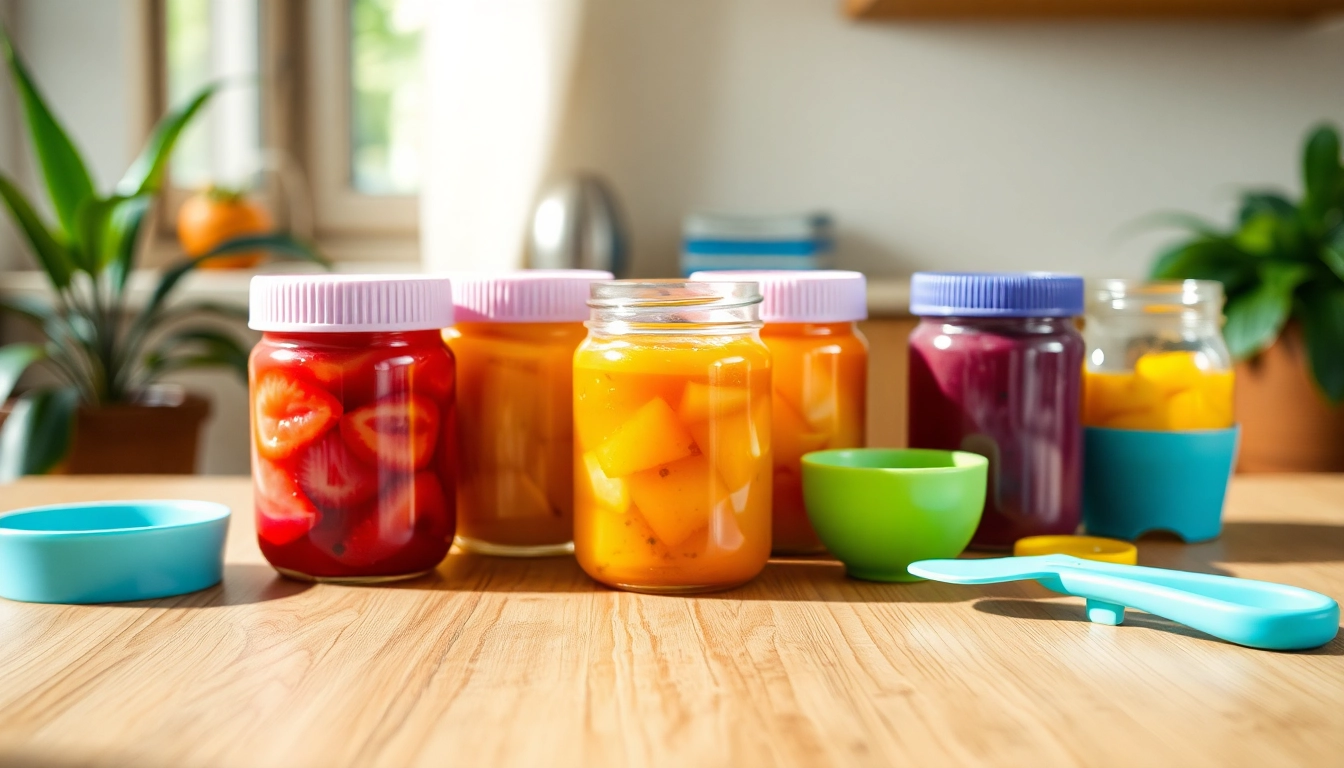Understanding Baby Weaning Foods and Their Importance
Baby weaning foods represent a crucial phase in an infant’s development, marking the transition from exclusive milk feeding to the introduction of solid foods. This stage not only provides essential nutrients for growth but also fosters the development of chewing, swallowing, and sensory skills. According to pediatric nutrition experts, early exposure to a variety of textures and flavors can significantly influence a child’s acceptance of nutritious foods later in life. For parents seeking the best start, understanding the significance of quality weaning foods—particularly those made with authentic Italian ingredients—can ensure that this transition is both safe and enjoyable. You can explore a range of options and expert guidance on quality baby weaning foods at Baby weaning foods.
Definition and Developmental Benefits of Baby Weaning Foods
Baby weaning foods are specially prepared natural foods designed to meet infants’ nutritional needs during the initial stages of solid food introduction, generally around 4 to 6 months of age. These foods are rich in vitamins, minerals, and other vital nutrients critical for healthy growth and development. The weaning process serves multiple developmental benefits: it enhances motor skills through the practice of chewing and swallowing; it stimulates sensory development by exposing babies to new textures and flavors; and it encourages the development of oral muscles essential for speech. Italian-made baby foods emphasize natural ingredients and safety, ensuring every meal supports optimal growth while respecting cultural culinary traditions.
Top Criteria for Selecting Safe and Nutritious Baby Weaning Foods
Genuinely Italian-made ingredients and safety standards
Choosing baby weaning foods that are genuinely Italian-made guarantees access to ingredients cultivated with exceptional standards and authenticity. Italy’s rich gastronomic tradition is backed by strict safety regulations, including rigorous ingredient sourcing and processing standards. Products like organic pasta, pureed vegetables, and fruit-based snacks are prepared with farm-fresh, locally-sourced ingredients, certified and controlled to meet the highest safety and quality benchmarks. This guarantees that infants are consuming wholesome foods free from artificial additives, preservatives, and contaminants.
Choosing organic, gluten-free, and allergen-free options
Many parents today prioritize organic and allergen-free options to reduce risks associated with food allergies or sensitivities. Organic baby foods are cultivated without pesticides or synthetic chemicals, preserving nutritional integrity. Gluten-free options are essential for infants with celiac disease or gluten sensitivities, ensuring they receive adequate nutrition without adverse reactions. Allergen-free lines focus on avoiding common triggers like nuts, dairy, or soy, helping to prevent allergic responses. At Bèbeboom, such options are widely available, providing peace of mind during the weaning transition.
Role of certifications and labels in quality assurance
Certifications such as “Organic,” “Made in Italy,” and safety seals from recognized authorities serve as trustworthy indicators of product quality. They confirm adherence to strict safety, ingredient transparency, and production standards. Certifications reassures parents that their choice of baby foods aligns with industry best practices and regulatory compliance, thereby reducing concerns about contamination or inadequate nutritional content. Reliable labels make the selection process more straightforward and provide confidence that the products meet or exceed safety standards.
Role of Silicone Accessories in Baby Weaning Foods
Benefits of silicone plates, bowls, and utensils for infants
Silicone accessories have revolutionized the way parents serve and manage baby meals. Their flexibility, durability, and safety features make them ideal for infants learning to feed independently. Silicone plates, such as the Rainbow Bèbeboom in the shape of an arc, feature multiple compartments that separate different food textures, encouraging variety and preventing mixing. Silicone bowls with suction cups, like the round and square ventosa models, stay firmly attached to high chairs or tables, minimizing mess and waste. Utensils made of silicone, such as ergonomically designed spoons and forks, facilitate self-feeding by offering an easy grip and soft surface that is gentle on delicate gums.
Design considerations for safe and easy meals
Design plays a vital role in the safety and functionality of silicone weaning accessories. Items should feature rounded edges, non-toxic materials, and secure suction bases. Bright colors and engaging shapes, like the rainbow-themed plates, stimulate visual interest and make meal times more appealing. Ergonomic handles ensure ease of grip for small hands, promoting independence. Furthermore, accessories should be dishwasher safe and free from BPA, ftalates, and other harmful substances, aligning with safety certifications to guarantee peace of mind.
How silicone accessories support motor and sensory development
These specialized utensils and dishes are more than just practical tools—they actively promote developmental milestones. Using silicone utensils helps infants improve fine motor skills, such as grasping and coordinated hand movements. The tactile qualities of silicone stimulate sensory exploration, aiding in the development of touch perception. Additionally, involving infants in self-feeding with safe, colorful accessories fosters confidence, independence, and positive associations with healthy eating habits—laying the groundwork for lifelong nutritious choices.
Practical Tips for Introducing Baby Weaning Foods
Gradual transition from milk to solid foods
The transition from milk to solids should be gradual and responsive to the baby’s cues. Start by introducing small quantities of smooth purees, gradually increasing texture complexity and meal frequency. Observing the infant’s reactions is essential: signs of readiness include good head control, ability to sit with support, and interest in food. Implementing a structured schedule with consistent mealtimes helps build routine and security. Using certified silicone feeders and dishes makes this process smoother and less messy, creating a positive environment for new experiences.
Creative presentation techniques to stimulate appetite
Presentation plays a significant role in encouraging infants to accept new foods. Bright, colorful plates shaped like rainbows or featuring fun characters attract curiosity and engagement. Incorporating a variety of textures—purees, small soft pieces, or mildly crunchy items—exposes babies to diverse sensory experiences. Mixing foods to create appealing combinations, such as fruit and cereal, can help cultivate a liking for wholesome ingredients. The use of playful utensils, ergonomic and easy for little hands, can turn meal times into enjoyable exploration rather than a chore.
Involving babies in meal times to promote independence
Encouraging infants to participate in feeding activities fosters independence and positive dietary habits. Offer small, manageable portions on silicone plate or bowl equipped with suction to prevent spills. Allow babies to use their utensils under supervision, reinforcing motor skills and confidence. Gentle encouragement and patience are essential—each small achievement builds their competence and love for nutritious foods. As they grow more accustomed to eating independently, their self-esteem and willingness to try new foods increase significantly.
Measuring Success and Ensuring Baby’s Healthy Growth
Monitoring intake and developmental milestones
Regular tracking of dietary intake and developmental progress ensures that the weaning process supports healthy growth. Use growth charts and consultation with pediatricians to verify weight, height, and nutritional adequacy. Observing milestones like chewing, self-feeding, and language development provides insights into overall progress. Maintaining a food journal can help identify triggers for fussiness or preferences, guiding menu adjustments to meet evolving needs.
Adjusting diet based on age and preferences
As infants mature, their dietary needs and preferences naturally change. Gradually introduce more complex textures, diversify ingredients, and incorporate culturally familiar flavors—especially those intrinsic to Italian cuisine, such as gentle pasta or organic vegetable purees. Flexibility and patience are key: catering to individual tastes enhances acceptance and promotes a positive relationship with food. Continually adapt portion sizes and ingredient combinations to ensure nutritional requirements are met without overwhelming the child.
Engaging healthcare professionals for guidance
Close collaboration with pediatricians and nutritionists is essential to tailor feeding strategies to each child’s unique growth trajectory. Regular check-ups allow for personalized advice, screening for allergies, and early detection of feeding difficulties. Professional guidance reinforces healthy habits, dispels doubts, and refines feeding approaches based on latest scientific insights and cultural best practices. At Bèbeboom, the commitment to rigorously controlled, calcium-rich, and natural Italian ingredients supports this holistic approach to infant nutrition.


